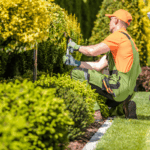
A Guide to HOA Landscaping and Common Area Maintenance Best Practices
September 24, 2025
How Professional Management Can Increase Property Values
October 1, 2025
Homeowners associations were initially created to protect property values and maintain neighborhood standards. But the most successful communities today recognize that their true purpose extends far beyond sending violation notices and collecting dues.
At Neighborhood Management, our experience shows that thriving communities strike a balance between effective governance and meaningful opportunities for connection. When residents feel genuinely engaged with their neighborhood, everything improves – from property values to volunteer participation to overall satisfaction.
Community Connections Matter
Drive through any neighborhood on a weekend afternoon. Some communities show visible signs of engagement – neighbors chatting in front yards, children playing together, residents enjoying common areas. Others appear pristine but eerily quiet, with beautiful homes but little evidence of actual community life.
This difference has a dramatic impact on the resident experience. People purchase homes in managed communities, seeking both property protection and a sense of neighborhood connection. When associations focus exclusively on rules while neglecting relationships, they miss half of what makes communities truly valuable.
Simple Engagement Strategies That Work
Creating vibrant communities doesn’t require elaborate programming or massive budgets. Some of the most effective initiatives are remarkably straightforward:
- Community gardens where neighbors interact naturally while pursuing shared interests
- Seasonal celebrations that create relaxed opportunities for connection
- Walking or fitness groups that combine exercise with relationship building
- Book exchanges or neighborhood libraries placed strategically throughout the community
- Volunteer projects that beautify the neighborhood while building camaraderie
These grassroots efforts succeed because they feel authentic rather than forced. They create natural spaces for building relationships without pressuring residents who prefer more privacy.
Making Technology Work For Your Community
Digital tools have transformed how associations operate, but technology alone cannot create community. The best technology solutions enhance face-to-face connections rather than replacing them.
Community websites make essential administrative functions like payments and maintenance requests more convenient. Communication platforms keep residents informed about neighborhood activities. Event calendars and social tools facilitate coordination and information sharing.
Neighborhoods with the highest participation rates use digital tools strategically, removing administrative barriers and creating more opportunities for meaningful interaction.
Reimagining Community Spaces
Many association amenities were designed decades ago and no longer match how people actually use community spaces today. Forward-thinking neighborhoods regularly reassess their common areas, making thoughtful modifications to increase usage.
Simple changes often produce dramatic results:
- Adding comfortable seating and WiFi to clubhouses creates flexible gathering spaces
- Installing conversation areas near playgrounds encourages parent interaction
- Converting underutilized formal rooms into multipurpose activity zones
- Creating dog-friendly areas where pet owners naturally socialize
- Redesigning pool decks with conversation zones rather than just rows of lounge chairs
These adaptations reflect how residents live today. Often, minor modifications significantly increase interaction without requiring expensive capital projects.
Developing Community Leadership
Board quality fundamentally impacts engagement success. The most effective associations provide board training that addresses both governance responsibilities and community-building approaches.
Beyond formal board positions, thriving neighborhoods develop broader leadership through:
- Committee structures that distribute responsibility across more residents
- Short-term project teams allowing contribution without long-term commitments
- Mentoring relationships pairing experienced volunteers with newcomers
- Recognition programs celebrating diverse community contributions
Communities that invest in leadership development create sustainable engagement that continues despite inevitable board transitions.
Smart Financial Decisions
Budget priorities reveal true community values. Many associations allocate substantial resources to physical maintenance while providing minimal support for relationship-building. This imbalance overlooks what drives neighborhood satisfaction and property values.
Communities with robust engagement programs consistently demonstrate measurable benefits:
- Faster property sales with higher closing prices
- Lower assessment delinquency rates
- Reduced rule enforcement costs
- Increased volunteer participation
- Higher overall satisfaction scores
Professional financial management helps associations recognize these connections and allocate resources strategically. Often, modest investments in engagement generate substantial returns across multiple performance areas.
Measuring What Matters
Most associations track financial metrics carefully while overlooking engagement indicators. This makes improvement nearly impossible – you simply can’t enhance what you don’t measure.
Practical assessment looks at both participation numbers and broader impact:
- Volunteer involvement rates across demographic groups
- New resident welcome program effectiveness
- Committee participation and leadership development
- Communication effectiveness through various channels
- Overall satisfaction measured through regular surveys
Regular measurement helps communities refine their approaches while demonstrating concrete results. Management partners play important roles in establishing assessment frameworks and providing context from other communities.
Professional Management Partnership
Volunteer boards bring passion, but they often have limited time and resources. Professional management provides essential expertise and infrastructure for sustainable community building.
This relationship works best as a genuine partnership rather than a traditional vendor arrangement. Management brings specialized knowledge about requirements, trends, and proven approaches. They provide administrative systems that simplify governance, while freeing volunteer leaders to focus on building relationships.
Experienced managers help associations anticipate challenges while implementing tailored engagement strategies based on each community’s unique needs.
Finding Your Community’s Personality
Cookie-cutter engagement programs rarely succeed. Communities have distinct personalities shaped by location, demographics, amenities, history, and countless other factors.
A retirement community needs different approaches than a family-oriented neighborhood. A newly developed community faces different challenges from an established association. Effective management helps associations discover their community’s unique character and create strategies that resonate with actual residents.
Building Long-Term Success
Building strong communities takes time. The best neighborhoods grow through these natural stages:
- Clear Communication – Getting everyone on the same page
- Neighbor Connections – Creating casual ways for people to meet
- Active Involvement – Offering meaningful ways to contribute
- Resident Ownership – Supporting homeowner-driven projects
Many HOAs rush straight to big programs without first building relationships. Good management helps communities take these steps in the correct order, creating neighborhoods that truly last.
Neighborhood Management specializes in helping associations develop tailored engagement strategies that enhance both property values and resident satisfaction. Our team has worked with all kinds of communities across the region for many years.
Contact us today to discuss how professional management support can transform your neighborhood into a community that residents truly love calling home.
For more information about Neighborhood Management’s approach to community association management, call 972-359-1548 or visit NeighborhoodManagement.com.






